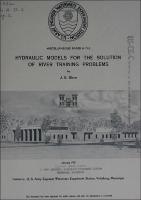Please use this identifier to cite or link to this item:
https://hdl.handle.net/11681/10760| Title: | Hydraulic models for the solution of river training problems |
| Authors: | Glover, James E. |
| Keywords: | Rivers River regulation River training Hydraulic structures Hydraulic models Movable-bed models Dikes Groins Navigation channels Sediment transport Sedimentation Deposition |
| Publisher: | Hydraulics Laboratory (U.S.) Engineer Research and Development Center (U.S.) |
| Series/Report no.: | Miscellaneous paper (U.S. Army Engineer Waterways Experiment Station) ; H-71-2. |
| Description: | Miscellaneous Paper Abstract: Movable-bed hydraulic models have proven to be a valuable tool in developing general principles and specific solutions to river training problems. Results to date (1970) of general studies at the U. S. Army Engineer Waterways Experiment Station to develop basic principles for use in design of both spur dikes or rock groins and longitudinal training or vane dikes, although not conclusive, have indicated the following: (A.) dikes can be designed to produce better results at lower cost; (B.) movement of currents near and within a dike field is an important consideration in dike design; (C.) spur dike systems should pave the highest elevation dike upstream and each succeeding dike downstream at a slightly lower elevation; (D.) reduction in shoaling in a channel is directly proportional to dike elevation; and (E.) vane dikes can be effective in deteriorating a secondary channel where divided flow is a problem. Models of actual river reaches for the investigation of plans for the improvement of unstable and troublesome reaches and for the development of adequate channel dimensions and improvement of channel alignment have indicated (1.) highly distorted and inexactly adjusted models when properly evaluated can be used to indicate quickly the effectiveness of proposed dike plans or indicate the comparative effectiveness of alternate plans; (2.) vane dikes may be as effective as spur dikes in shifting a channel with less total length of dike; (3.) there is less tendency for a channel to develop along the face of vane dikes than along the ends of spur dikes; and (4.) spur dikes produce a deeper channel than vane dikes with the same control channel width. |
| Rights: | Approved for public release; distribution is unlimited. |
| URI: | http://hdl.handle.net/11681/10760 |
| Appears in Collections: | Miscellaneous Paper |
Files in This Item:
| File | Description | Size | Format | |
|---|---|---|---|---|
| MP-H-71-2.pdf | 9.37 MB | Adobe PDF |  View/Open |